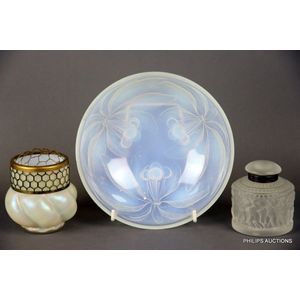1930s Lalique, Kralik, and G. Vallon Glass Collection
A Lalique scent bottle, a Kralik vase, and a G. Vallon bowl, circa 1930s and after, a Lalique 'Enfants' scent bottle, introduced in 1931, pattern 609, with a later silver plated collar, inscribed Lalique France, a Kralik, Mother-of-pearl' spiral lobed vase with brass honeycomb collar and frog, a G. Vallon opalescent moulded 'Cherries' bowl, moulded mark of G. Vallon, made, in France, height 2.95 in., diameter 9.65 in. (bowl)
You must be a subscriber, and be logged in to view price and dealer details.
Register Now to view actual auction price for this item.
- Opalescent / Opaline - The descriptions of glass as "opalescent" or "opaline" are often used interchangeably by dealers and auction houses. At the upper end of the scale, opalescent / opaline glass can refer to the opal-like milky blue glass produced by Lalique and Etling. It also refers to the pressed glass mass produced in Britain from the 1840s with a milky white edge as sugar-basins, milk jugs and vases were made in great quantities for the mass market, and were sold at fairs along with Staffordshire figures and wooden dolls. A less common type of opalescent glass was made from two layers of glass blown into a mould.
- Mother-Of-Pearl - Mother-of-pearl, technical name "nacre", is the inner layer of a sea shell. The iridescent colours and strength of this material were widely used in the nineteenth century as an inlay in jewellery, furniture, (especially papier mache furniture) and musical instruments.
In the early 1900s it was used to make pearl buttons. Mother-of-pearl is a soft material that is easily cut or engraved.
Nowadays it is a by-product of the oyster, freshwater pearl mussel and abalone industries. - Circa - A Latin term meaning 'about', often used in the antique trade to give an approximate date for the piece, usually considered to be five years on either side of the circa year. Thus, circa 1900 means the piece was made about 1900, probably between 1895 and 1905. The expression is sometimes abbreviated to c.1900.
This item has been included into following indexes:
